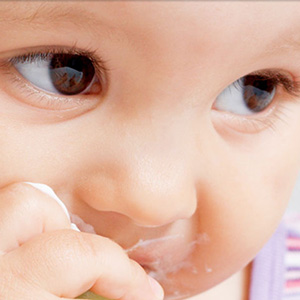INSIDE: Are you confused about what a 7-month-old feeding schedule looks like? This blog covers everything you need to know in 10 easy steps.
You’ve nailed carrot, cauliflower and organic broccoli foraged from the farmers’ market. Weaning’s a breeze (or maybe a raging storm?!). But what next?
You know you need to move on with more meals, more flavours and more textures. And how’re you supposed to fit this all the other things you need to do?
No panic. I have you covered in TEN easy steps.
Bonus: As a bonus for joining my weekly newsletter, get this free cheat sheet of 7 simple baby breakfast ideas you can easily share.
# 1 Be realistic: Real-world weaning vs Instagram weaning
Balancing food and milk feeds can seem complicated. However, be wary of authoritarian and unrealistic meal plans in weaning books and on Instagram. While it’s helpful to have a general guide on creating a feeding schedule for your baby, detailed plans can be restrictive when followed to the letter.
And they go against the philosophy of including your baby in family meals.
Variety is critical during weaning to expose your baby to various foods. But it’s unrealistic and unsustainable to prepare seven different dishes for breakfast, lunch and dinner every week just for your baby.
#2 Offer the right amount of meals for your baby’s age
How often should a seven-month-old feed?
You should offer your baby three scheduled meals a day at about seven months. They might not eat all the food you offer, and some days they may altogether refuse a meal, which is OK.
It’s your job to provide the food; it’s your baby’s job to eat it (or not!).
You’ll find sample timings in my feeding guide, but please don’t feel obliged to stick with these. Work out a schedule that works for you, your baby and the rest of the family.
Ready, Steady, Wean-From Confused To Confident In No Time At All
Save yourself time, stress and money and get all the answers you need in one easy-to-follow online course.


Here’s a little secret about weaning!
#3 Don’t stress about portion sizes-I’ll let you in on a secret!
Hands down, one of the most common questions I’m asked is, “How much should my seven-month-old be eating?”
Guess what? I’ll let you in on a secret!
There are no recommended portion sizes for weaning. So, always feed your baby responsively.
Start with a bit of food, and if they want more, offer more. And keep in mind that it’s pretty normal for babies’ appetites and food intake to vary from meal to meal.
# 4 Trust your breastfed baby to balance milk and solids
Continue to breastfeed your baby on demand.
This probably means breastfeeding before meals (aka starter!), as well as between meals (aka snack) and after meals (aka dessert or coffee!) and more than likely multiple times at night as well.
Some babies may reduce the number of feeds as they eat more. And some babies will breastfeed at the same frequency but for shorter periods. With your baby, you might not notice any change.
Breastfed babies do a great job at regulating their milk intake. So, as their intake of solid food increases, their milk intake decreases.
Trust them, and you can’t go wrong.
How long you leave between milk and solids is up to you. Some babies will eat lunch even if they’ve just had breastmilk. Others won’t. These babies benefit from a gap between milk and solids. You’ll work out a routine that’s right for you. A way that changes as your baby starts to eat more meals and possibly more significant amounts at each meal. It also varies from day to day.
Some days your baby will want more milk, and on others, more food. Go with it.

Your baby will find a balance between milk and solids
# 5 Help your bottle-fed baby balance milk and food
How much milk should a seven-month-old drink?
Between 7-9 months, your baby needs about 20oz (or 600mls) of milk.
But how many bottles a day is that? When can I drop a bottle? (every parent’s wish!)
How many bottles a 7-month-old baby drinks varies. Some babies like to drink bigger bottles (maybe 3 x 7oz) and others smaller, more frequent bottles (e.g. 4 x 5oz). Do what suits you and your baby.
There’s no need for a follow-on formula. Stick with your first infant formula until your baby’s first birthday, when you’ll switch to cow’s milk.
#6 It’s not worth cramming in snacks into your busy day!
Generally, babies of this age don’t need snacks between meals as milk functions as a snack in most cases. And between three meals, milk feeds and naps, it can be challenging to fit in any more eating opportunities!
Snacks are more relevant when your baby turns one.

It’s hard to fit snacks into a busy day
At about seven months (or before), you should offer your baby a range of vegetables, fruits, cereals, meat, fish or veggie alternatives like beans, lentils, tofu and other foods your family eats.
Check out this guide on how to introduce potentially allergenic foods.
However, what format the food takes exactly is up to you! The best food for your baby is an adapted version of your family food, as it is the food you’ll be hoping your baby eats as a toddler and older child.
One of the most common questions parents ask is, ‘should I give my baby two dinners a day?’. Again this is totally up to you. As long as you cover the main food groups at all three meals, it doesn’t matter if it’s a hot or cold dish, a spoon-fed meal or finger food.
YOU’LL LIKE THIS TOO: Baby meal ideas you can make from your cupboard
# 8 Don’t let fear hold you back: Move on with lumps
If you’re offering your baby food from a spoon, then by seven months, ensure that most of your baby’s food is mashed rather than puréed. Although some purées like soups, yoghurt and hummus are fine.
You should also offer your baby finger foods at each meal, either alongside food from a spoon or as an entire finger food meal.
# 9 Embrace water as a mealtime drink
You can offer your baby cooled boiled water to drink with their meals. Serve this from an open or straw cup.
How much water should a seven-month-old drink?
You don’t need to measure this. Offer your baby sips of water with meals. Some babies readily take to the water (and drink from cups), and others don’t. Breast milk or formula continues to be your baby’s main drink until their first birthday.
# 10 No-nonsense, flexible 7-month-old feeding schedule
- 7 am: Offer milk (breastfeed on demand or about 5oz bottle)
- 8 am: Breakfast (Porridge or Weetabix with milk and toppings or eggs with fruit or veggie finger food).
- 10 am: Offer milk as before
- Noon: Dinner (include iron-rich food, energy food and a fruit or vegetable).
- 2 pm: Offer milk as before
- 5 pm: Tea (include an iron-rich food, energy food and a fruit or vegetable).
- 7 pm: Bedtime milk (as before!)
Questions parents often ask me
What can I give my seven-month-old for breakfast?
Your baby has no preconceived ideas about breakfast food, so you can provide a bean casserole if you like!
However, typical breakfast foods are fine too. Again keep it simple here.
What do you typically eat in the morning? Could your baby share your porridge with you?
Alternatively, low sugar, low salt instant oats (like Ready Brek) are nutritious and fortified with iron. You can customise them with toppings like mashed fruit, ground seeds and nut butter. Eggs are always a handy option too.
RELATED: Easy ways to serve Weetabix for babies-and why to do it!
Do babies drink less milk after starting solids?
Breastfed babies are typically very good at regulating their milk intake when they start solids; however, not all babies reduce their milk intake because it’s easier for babies to overfeed from bottles. You may have to take the lead in reducing the milk you offer. And always feed your baby responsively. Never ‘encourage’ your baby to finish a bottle.
Should I worry if my baby isn’t eating much?
Some babies eat lots, others eat very little, and many are somewhere between. It’s still early in your baby’s food journey, and they have much to learn.
Not every baby enjoys spoon-feeding by their parent, and many prefer self-feeding, but their stamina and skills for self-feeding are still limited.
- Be patient
- Keep offering three meals a day.
- Include your baby in family meals as much as possible.
- Avoid using tricks to get your baby to eat when they clearly show you they’re not interested. Pressure (good like ‘here comes the aeroplane and bad) always backfires.
If you’re worried about your baby’s growth and development, talk to your GP and PHN as the first step. They’ll have a record of your baby’s growth chart since birth and can do an up-to-date weight check for you. If necessary, then talk to a registered dietitian for one-to-one advice.
There’s nothing wrong with carrot, cauliflower or organic broccoli from the farmers market (or Aldi!). Still, I hope you feel a bit more confident now to supplement these foods with a wider variety of tastes, textures and meals. Enjoy!
Get Your Free Breakfast Cheat Sheet
When you’re in the thick of a busy morning, it can be challenging to come up with varied breakfasts for you and your baby. So, here’s a week’s worth of ideas to stick on the fridge!
- Get the free cheat sheet. You’ll get the cheatsheet, plus join my weekly newsletter! Just click here to get it and subscribe.
- Print or download it onto your phone.
- Hang your cheat sheet somewhere handy, like the fridge. Or save it in a folder on your phone.
Ready, Steady, Wean-From Confused To Confident In No Time At All
Save yourself time, stress and money and get all the answers you need in one easy-to-follow online course.








0 Comments